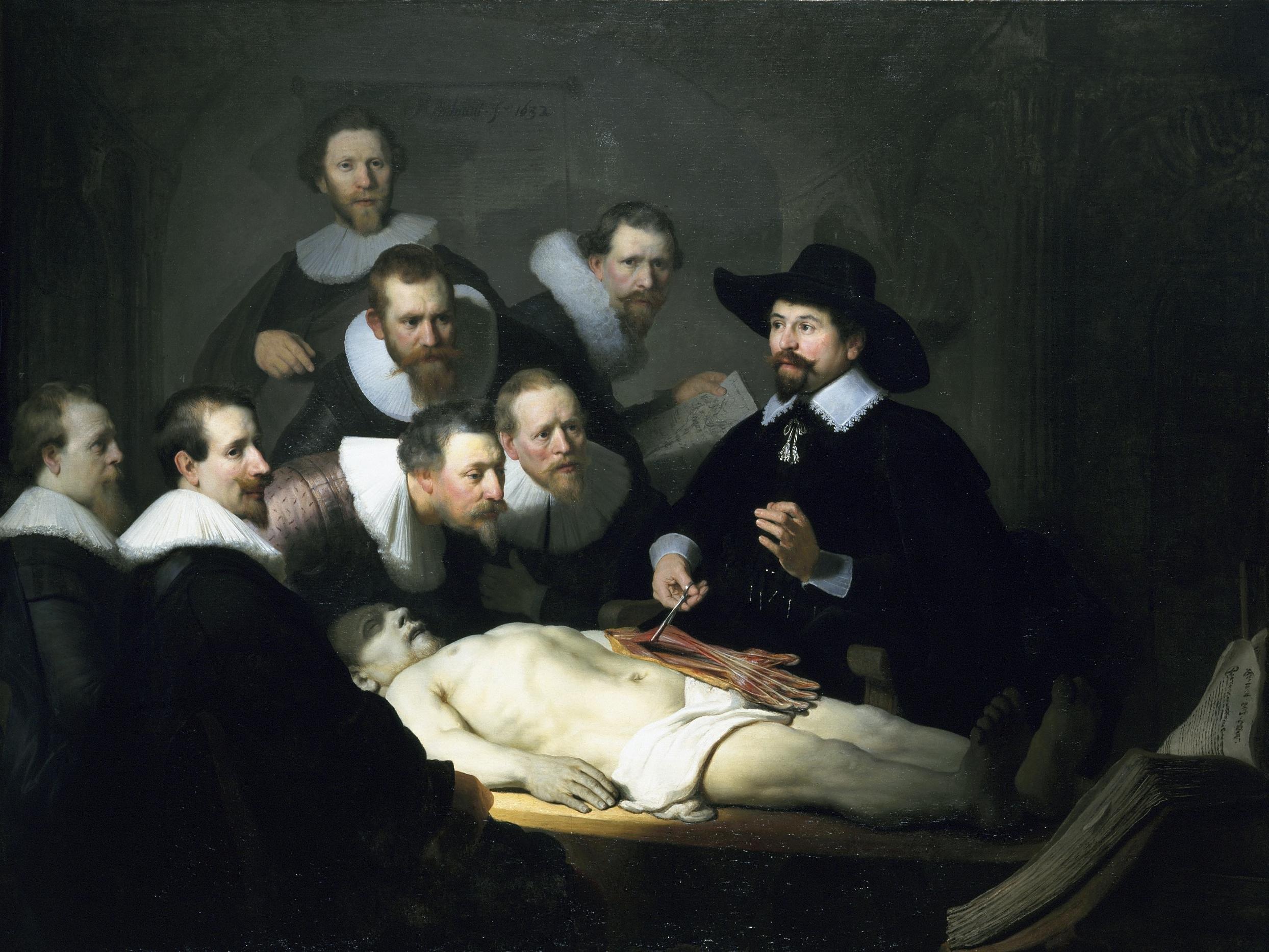- Anatomy Lesson of Dr. Nicolaes Tulp
Infobox Painting|

title=The Anatomy Lesson of Dr. Nicolaes Tulp
artist=Rembrandt
year=1632
type=Oil on canvas
height=Convert|216.5|cm
width=Convert|169.5|cm
city=The Hague
museum=Mauritshuis "The Anatomy Lesson of Dr. Nicolaes Tulp" is a 1632
oil painting byRembrandt housed in theMauritshuis museum inThe Hague , theNetherlands .Dr.
Nicolaes Tulp is pictured explaining the musculature of thearm to medical professionals. The corpse is that of the criminalAris Kindt , strangled earlier that day for armed robbery. Some of the spectators are various patrons who paid commissions to be included in the painting.The event can be dated to
16 January 1632 : theAmsterdam Guild of Surgeons , of which Tulp was official City Anatomist, permitted only one publicdissection a year, and the body would have to be that of an executed criminal.Anatomy lessons were a social event in the 17th century, taking place in lecture rooms that were actualtheatre s, with students, colleagues and the general public being permitted to attend on payment of an entrance fee. The spectators are appropriately dressed for a solemn social occasion. It is thought that, with the exception of the figures to the rear and left, these people were added to the picture later.One person is missing: the Preparator, whose task it was to prepare the body for the lesson. In the 17th century an important
scientist such as Dr. Tulp would not be involved in menial and bloody work likedissection and such tasks would be left to others. It is for this reason that the picture shows no cutting instruments. Instead we see in the lower right corner an enormous opentextbook on anatomy, possibly the 1543 "De Humani Corporis Fabrica" ("Fabric of the Human Body") by Andreas Vesalius.Medical specialists have commented on the accuracy of
muscle s andtendon s painted by the 26-year-old Rembrandt. It is not known where he obtained such knowledge; it is possible that he copied the details from an anatomical textbook. However, recent Dutch research revealed several discrepancies of the exposed left forearm compared to that of a real male cadaver. [Citation
last = F. IJpma "et al."
contribution = The anatomy lesson of Dr. Nicolaes Tulp by Rembrandt (1632): a comparison of the painting with a dissected left forearm of a Dutch male cadaver
title = J Hand Surg [Am]
year = 2006
volume = 31
issue = 6
pages = 882-891
url = http://www.handsurg.eu/resources/rembrandt_en.pdf]The face of the corpse is partially shaded, a suggestion of "umbra mortis" (shadow of death), a technique that Rembrandt was to use frequently.
The painting is signed in the top-left hand corner "Rembrandt f [ecit] 1632". It is the first known instance of Rembrandt signing a painting with his forename as opposed to the initials "RHL" (Rembrandt Harmenszoon of
Leiden ), and is thus a sign of his growing artistic confidence.References
* [http://endeavor.med.nyu.edu/lit-med/lit-med-db/webdocs/webart/van.rijn95-art-.html "The Anatomy Lesson of Nicolaes Tulp" at the Literature, Arts & Medicine Database]
* [http://www.maitrise-orthop.com/corpusmaitri/orthopaedic/86_masquelet/masqueletus.shtml Rembrandt's "Anatomy Lesson of Professor Nicolaes Tulp" by A.C. Masquelet]
*Heller, Joseph (1988), "Picture This", Scribner Paperback Fiction, ISBN 0-684-86819-9Notes
Wikimedia Foundation. 2010.
